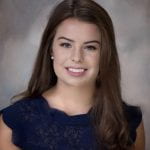Undergraduate Research Awards
The PC Undergraduate Research Committee’s (PC-URC) Summer Undergraduate Research and Creative Grant program provides funding for stipends and research expenses in order for students to conduct research and creative projects on- or off-campus for up to 10 weeks during the summer under the guidance of a faculty mentor.
The Undergraduate Research Grants Review Committee announces the Summer 2025 Undergraduate Research and Creative Projects Awards.
Summer 2025 Veritas Undergraduate Research Awards
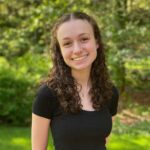
On the Sunny Side of the Street: An Original Novel
Alyssa Caneira ’26, Creative Writing
Faculty Mentor: Dr. Alison Espach, English
“On the Sunny Side of the Street” is the first draft of a historical novel about a young working-class Portuguese-American woman growing up in post-WWII Connecticut who enters a beauty pageant in the hopes of winning a college scholarship. Drawing on a combination of true stories from my great-grandparents and supplemental research, this original story will explore the importance of ancestral roots, the bonds of family and sisterhood, the tension between the postwar feminine ideal and women’s higher education, and the persistence of joy through faith.
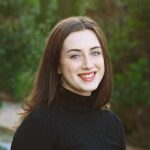
Determining the Efficacy of Bunsen Burner Usage When Working with Microorganisms
Kate DeVincent ’28, Health Sciences
Faculty Mentor: Dr. Hannah Gavin, Health Sciences
In medical and laboratory settings, disinfection (intentional removal of microbes) ensures patient safety and experimental efficacy. When working with microorganisms, standardized practices to maintain sterility include the use of a Bunsen burner to push contaminated air upwards, away from a researcher’s workspace. Surprisingly, our literature review revealed that this practice is credited to theory rather than experimental evidence, and its implementation is variable among scientists. Here, we propose a series of laboratory experiments to test the Bunsen burners’ efficacy, wherein we intentionally expose burner-adjacent Petri dishes to airborne microbes with and without active flame, then quantify microbial growth in each scenario. Both because of predicted effect on airflow and use among the research community, we hypothesize that the flame will reduce contamination from airborne microbes. Even if our hypothesis is refuted, our data will increase repeatability and reliability in researchers’ experimental results by supporting more uniform and evidence-based practices.
Mechanistic Studies of Drug-Modifying Azoreductase Enzymes
Robert Ghergurovich ’26, Biochemistry
Faculty Mentor: Dr. Tyler Stack, Chemistry and Biochemistry
Broadly, our goal is to characterize enzymes found in human gut microbiome, seeing if they can metabolize certain drugs and food dyes. Specifically, azoreductases are a class of enzymes known to reduce azo compounds, but the mechanism is unknown. One proposed mechanism is that azoreductases do not reduce the azo bond itself, but rather act as quinone reductases through reducing the compound in its hydrazone tautomer. To elucidate this mechanism, we synthesize and kinetically test the rate of azoreduction of different azo compounds to examine how changing these molecules will electronically affect the rate of azoreduction.

SmartSip
Neve Palmeri ’27, Management and Marketing
Mentor: Kelly Ramirez, Donald Ryan Incubator for Entrepreneurship in the Arts and Sciences
SmartSip is an innovative safety device designed to detect the presence of date rape drugs in beverages. This patent-pending straw changes color upon detecting common date rape drugs, providing an immediate visual alert to potential danger. SmartSip aims to enhance personal safety in social settings, offering a discreet and reliable tool to prevent drug-facilitated assaults. This research project will involve a collaborative approach, with my focus on the business and operational aspects, including market research, funding strategies, and commercialization pathways. Simultaneously, a fellow student with a chemistry background will lead the development and refinement of the chemical detection technology. Together, we aim to optimize manufacturing processes and prepare SmartSip for market introduction, empowering individuals to protect themselves and their loved ones.
Creativity AI
Veronica Smith ’27, Psychology and English
Faculty Mentor: Dr. Andra Geana, Neuroscience/Psychology
In a world where Artificial Intelligence is increasingly shaping professional fields, it is essential to understand its impact on problem-solving skills. This study explores how image-generative AI (Adobe Firefly) influences creativity when participants describe hybrid animals and unique places. Fifty participants will be randomly assigned to a control group, which generates descriptions without AI, or an experimental group, which uses Adobe Firefly to visualize their descriptions. Creativity levels will be evaluated using a Creativity Assessment Tool (CAT) and two computational analysis tools: Coh-Metrix, which assesses textual cohesion and readability, and Linguistic Inquiry and Word Count (LIWC), which analyzes psychological categories within the text. The study aims to determine whether AI enhances or restricts creative expression in problem-solving tasks. These findings will contribute to our understanding of AI’s role in fostering creativity and its implications for fields that rely on innovation and imaginative thinking.
Summer 2025 Undergraduate Research Awards

The influence of Arab-American children’s books in shaping social and political identity: exploring the effects of representation, banning, and cultural perception
Judy Akid ’27, Political Science
Faculty Mentor: Dr. Gizem Zencirci, Political Science
Children’s books hold an irrevocable position in shaping the minds of the youth. They are encouraged, celebrated, and praised nationwide. Children’s books usually target specific topics or themes to provide a fun story with a lesson in the hidden background. However, how do these books affect the development of a child’s political and social identity? In this project, our concern lies in Arab-American children’s books, and the goal is to examine them by seeking how different themes, representations, and patterns are portrayed in various texts. Further, interpreting the presentation of social and political problems in books, the impact of visuals, and the consequences of book banning would assist in coming to our conclusion. By accomplishing this, the study would provide a comprehensive representation of the effect of Arab-American books on children, advocating for their presence and the benefits of diversity in children’s books to promote tolerance.
Use of wheel-running to identify differences in circadian rhythm of animals with genetic differences causing neurological disorders
Campbell Bridges ’27, Biology
Faculty Mentor: Dr. Pamela Snodgrass, Biology
In this experiment we hope to evaluate the circadian rhythms of PTEN Knock-Out mice, an autism spectral disorder model, that demonstrates impaired sociability but also marked differences in the cells of the cerebellum. We hope to see if there are changes in circadian rhythms prior to the PTEN loss of function taking full effect in the Purkinje cells. We will measure wheel running by plotting the number of wheel rotations and the times at which they occur. Animals will be recorded in both a 12/12 light dark cycle condition as well as a constant dim light condition. At 3 weeks, the animals will be euthanized, and brain regions will be measured for up regulation of clock genes through qPCR. We can gain a better understanding of the 24-hour circadian clock in a model system by observing their behavioral and physiological activities, like activity and rest, fasting and feeding, and neuroendocrine signals.

Designing a Method of Detecting Common Date-Rape Drugs using DNA-silver nanoparticles Bound to a SilicaSurface
Lenna Doyle ’27, Biology
Faculty Mentor: Dr. Jay Pike, Chemistry
Our project aims to develop a silica straw embedded with immobilized DNA-silver nanoparticle (DNA-AgNC) probes capable of detecting ketamine, a common date-rape drug, in beverages. The research will begin by replicating reactions from previous research that have proved DNA produces a significant color change when bonded to ketamine. We will then evaluate the response of DNA-AgNC probes across varying concentrations of ketamine.The next phase involves exploring methods to immobilize the DNA-AgNC probes on a solid support, such as within a polymer matrix while preserving its ability to detect ketamine. In the final stages of the project, we will test the sensor in the presence of common beverage components like alcohol, citrus, and bitters to evaluate the probe’s response to chemicals in drinks. The ultimate goal is to initiate the development of a color-changing straw that could be used discreetly in public settings to promote safety and prevent drug-assisted assaults.
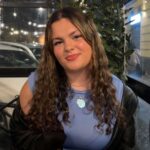
Leadership & Title IX: Does Political Ideology Shape University Supportive Measures?
Jillian Evans ’26, Political Science and Communications
Faculty Mentor: Dr. Andrea McDonnell, Political Science and Communications
This project explores the potential correlation between university presidents’ political affiliations and the availability of Title IX supportive measures and resources offered at public universities in the United States. Title IX, by law, requires institutions to address and prevent sex-based discrimination, yet the resources and measures available to support victims of sexual misconduct can vary widely, raising questions about what causes these disparities. By analyzing political donation records from the Federal Election Commission and the Title IX policies of the 50 highest-ranked public universities in the United States, this project aims to identify potential correlations between a university president’s political ideology and the level of institutional support provided to victims of sexual misconduct and harassment. By identifying potential connections, this research aims to highlight the influence that political ideology may have on university leadership decisions.

The 1820 Continental Travel Journals of Dorothy and Mary Wordsworth
Kaitlyn Fuoco ’26, English/Secondary Education
Faculty Mentor: Dr. Bruce Graver, English
Influential author of English Romanticism William Wordsworth first identified his passion for writing during a 1790 tour of the Alps. In 1820, William retraced this journey with his sister Dorothy and wife Mary, who documented their experiences in travel journals. Mary’s journal is about 75,000 words and has never been published. Meanwhile, Dorothy’s journal consists of over 200,000 words and was only partially published a little under a century ago. Through my research, I will work to transcribe and analyze both handwritten travel journals. As family members, Dorothy and Mary provide a unique insight into the life of a man that has produced influential poetry, such as The Prelude, from his original continental tour. This research will be contributing to the current body of knowledge about the life of William Wordsworth as well as be bringing awareness to the significance of female authorship in the 19th century.
Impact of Certificate of Need on All Cause Mortality Rate
Andrew Gilbride ’26, Quantitative Economics
Faculty Mentor: Dr. James Bailey, Economics
Certificate of Need (CON) legislation is currently present in 35 states including the District of Columbia. CON laws regulate healthcare facilities smaller than hospitals requiring them to apply for approval of any new infrastructure. One of the main goals of CON is the reduction of Healthcare Costs. An equally important goal is to provide quality care to state residents. The impact of CON legislation on all cause mortality was found to be not statistically significant (Bailey, 2018). However, data for that research was limited to 1992-2011. CON legislation was significantly altered, or suspended, during the COVID-19 and remained altered after the Pandemic. Given the dramatic change of the COVID-19 pandemic and the ever changing CON legislation of States, the impact of CON has a clear need to be reexamined when compared to all cause mortality.
“Let the Goddess Guide”: Athena, Columbia, and the Female Figure of Imperial Ideology
Bridget Goguen ’26, History
Faculty Mentor: Dr. Jessica Blum-Sorensen, History and Classics
In researching the significance of the Greek goddess Athena within Athenian society—and examining why and how Americans crafted their national personification, Columbia, from her image—I aim to reveal the enduring influence of the wise, valiant goddess archetype and its effectiveness as a tool for justifying ideology, navigating wartime uncertainty, and fostering national unity. Necessary for this is an investigation into the artists—the poets and painters, sculptors and sketchers—behind the images of both Athena and Columbia. How did they create a fictional figure who wielded real power? There is a timeless magnetism to mythology, and this project seeks to pinpoint the appeal of Greco-Roman emblems to a nascent American society, as well as the formative impact of the resulting Columbia character on the social and political foundations of the United States.
Investigating pathways regulating size-dependent accumulation of mitotic activator Cdc25
Benjamin Kuran ’26, Biology and Global Studies
Faculty Mentor: Dr. Kristi Miller, Biology
In this project, we hope to be able to better understand the pub1 and pka1 genes and their role in regulating the mitotic activator Cdc25. These genes have been shown to regulate the Cdc25 protein negatively, but it is unclear if these proteins work in the same pathway or independently of one another. To test this, I will be using a double mutant yeast strains that have both pub1 and pka1 genes removed from the genome. These will then be analyzed using quantitative microscopy and protein stability assays and compared to single deletion mutants to see the effects on Cdc25 concentration. I will also be creating a plasmid, which will be altered to remove the catalytic serine on the pka1 gene and integrated into the genome to see if pka1 is directly phosphorylating Cdc25. Through these experiments, I will uncover the pathway and improve our understanding of these oncogenes.

Exploring Community Narratives Through Portraiture: Bridging Creative Writing and Public Service
Riley Londraville ’27, Creative Writing and Public and Community Service Studies
Faculty Mentor: Dr. Carmine Perrotti, Public and Community Service Studies
My research explores the intersection of my two majors—Public and Community Service Studies (PSP) and Creative Writing—through the qualitative methodology of portraiture. Portraiture combines qualitative inquiry with storytelling to create detailed portraits of people, communities, or organizations. It emphasizes real-life experiences, highlighting strengths and voices that might otherwise be overlooked. Rather than simply collecting data, portraiture paints a rich picture of those involved, blending research with narrative expression (Burton & Johnson,2010; Lawrence-Lightfoot & Hoffmann Davis, 1997). I plan to transform qualitative data from community interviews I conducted through my participation in the Neighborly Engagement Research Lab (NERLab) into narrative stories, accompanied by photographs, that highlight diverse perspectives and experiences of local residents in the 02908 area while staying true to my voice as a writer. My guiding research question is: How do local residents describe how neighborliness presents itself between campuses and communities?
Effects of music tempo and genre on attention mediated by arousal
Ethan Moore ’26, Biology and Psychology
Faculty Mentor: Dr. Joanna Morris, Psychology
This project will examine how music affects attention, by way of its influence on levels of arousal which have been linked to attention. The relationship between attention and arousal is that of an inverted U, where moderate arousal levels are associated with optimal attention, while too little or too much arousal can impair attentional performance. This is a nuanced mechanism as increasing tempo will have differing effects on arousal for different musical genres. We plan to administer an easy yet monotonous task (lexical decision judgments) over the course of about one hour. Participants will perform the task while listening to country music, jazz music, or a metronome at either a high or low tempo. We will then examine accuracy, response time, and ERPs (brain activity) to these judgments to analyze performance and attention. This will help us further understand the mechanism of how music genre and tempo stimulate the brain.
Tuning Redox Properties of α-Diimine and Iminopyridine Ligands for Iron-Based Electrocatalytic Reactions
Sean Peloquin ’26, Biochemistry
Faculty Mentor: Dr. Maria Carroll, Chemistry and Biochemistry
This project investigates how modifications to redox-active α-diimine and iminopyridine ligands affect their reduction potentials and potential for catalytic activity. By synthesizing new ligands with different substituents, specifically replacing methyl groups with phenyl groups, we aim to understand how these changes influence the ligands’ redox behavior when bound to zinc or iron centers. Cyclic voltammetry will be used to measure reduction potentials of the zinc complexes, while iron tricarbonyl complexes will be synthesized to test their reactivity with acid and carbondioxide. The ultimate goal is to identify ligand structures that enhance catalytic performance in sustainable transformations like hydrogen gas generation or CO₂ reduction, using metals such as iron. This work contributes to the broader effort of developing efficient and cost-effective catalysts for addressing environmental challenges.

Association between Heart Rate Variability, Aerobic Capacity, and Body Composition in Young Healthy Individuals
Shea Podbelski ’27, Health Science
Faculty Mentor: Dr. Matthew Ely, Health Science
The aim of this project will be to discern the differences in heart rate variability (HRV) in young healthy and very fit individuals as well as the relationships that HRV has with aerobic capacity and body composition in such individuals. We will accomplish this by measuring HRV with an EKG, using DXA technology to measure body composition i.e. lean tissue and fat mass, as well as a maximal oxygen consumption test (VO2 peak test) to interpret the subjects’ aerobic capacity. Using this information all together, we hope to find relationships between the data collected and a correlation with HRV in young fit individuals as opposed to what is already understood about HRV and diseased populations.
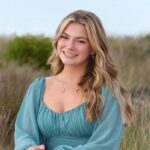
Institutional Courage, Justice and Healing: A Participatory Action Research Project to Improve College CampusResponse to Sexual Violence and Center Survivors
Emma Preston ’27, Social Work and Psychology
Faculty Mentor: Dr. Molly Driessen, Social Work
This project explores how institutions of higher education can better help undergraduate students who have experienced campus-based sexual violence and increase campus resources. Specifically, data is currently being collected in the form of a national mixed methods study led by Dr. Molly C. Driessen, my faculty advisor for this project, from survivors of campus sexual violence. The purpose of this summer research project is to engage in data analysis of this study, specifically through the lens of exploring the role of social media as a critical tool for advocacy, sharing resources, and dissemination of findings. The findings of this research will inform how to help strengthen institutional responses. The data analysis is necessary to create relevant steps to foster growth for those who have faced sexual assault at the college level and create meaningful change.
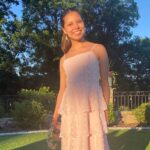
Navigating Anti-Immigrant Landscapes in ‘Welcoming’ States: How Place and Community Shape Immigrant Experiences in NY and MA
Marilyn Roque-Velasquez ’26, Political Science and Sociology
Faculty Mentor: Dr. Kara Cebulko, Sociology and Global Studies
This research project explores how immigrants respond and adapt to a political climate in which anti-immigrant policies and rhetoric have significantly intensified in 2025. Although previous administrations – both Democrat and Republican – have enforced immigration laws, enforcement has escalated considerably under the current administration, instilling fear and uncertainty within immigrant communities. As a result, many have turned to their state or local communities for support, though it can vary widely across and within states. Therefore, this project aims to answer: How are immigrants responding or adapting to the current political landscape and what role do their local communities and institutions play in navigating this landscape? Through interviews and field notes in two different states, I hope to answer these questions that are central in understanding immigrants’ sense of belonging in the U.S., which is constantly evolving alongside politics.
AgRP axonal projections in the periaqueductal gray influence on visual stimulus versus hunger motivation
Francesca Schaub ’26, Biology and Psychology
Faculty Mentor: Dr. Ryan Post, Neuroscience
Using a mouse model, we can study how motivation switches between hunger and fear to better understand the neural circuits that underlie this flexibility. To do this, I will place food directly underneath a visual looming threat stimulus while using optogenetics to stimulate neural pathways of hunger-sensitive neurons. A leading hypothesis states that hunger-sensitive neurons “turn off” neurons that respond to threat to prioritize food consumption. To test this hypothesis, I will optogenetically stimulate the axons of inhibitory hunger-sensitive neurons in the periaqueductal gray, a brain region where hunger and visual threat information are thought to intersect. The neural mechanisms of competing motivations between hunger and fear will be examined. A looming stimulus assay will be utilized to derive data regarding both hunger and fear to determine the periaqueductal gray’s influence on different neural systems.
Summer 2024
Veritas Awards
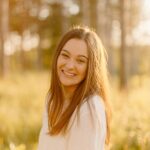
Unintended Consequences: Assessing the Impact of Dobbs v Jackson (2022) on the Provision of Maternal Healthcare in Cases of Obstetric Emergencies in the United States
Lauren Carson ’25 Political Science and Health Policy and Management
Faculty Mentor: Dr. Abigail Brooks, Women’s and Gender Studies and Sociology
The goal of this project is to assess the impact of the Dobbs v Jackson Women’s Health Organization (2022) decision on the provision of maternal healthcare in the United States. Since the decision, many healthcare providers across the political spectrum and from a diversity of backgrounds have spoken out about state level restrictions on care, particularly in instances of obstetric emergencies. This project will utilize case studies to analyze any potential correlations between state level reproductive healthcare policy, especially in terms of specific language used, and the ability of healthcare providers to administer adequate care for patients in obstetric emergencies. This project will also analyze the experience of patients from an intersectional lens, looking at the ways in which racial, classed, and geographical differences coincide with state level policy to impact patient treatment in obstetric emergencies.
HI Spectral Emission of Supernova Host Galaxies
Gregory Chepega ’26, Pre-Engineering
Faculty Mentor: Dr. Joseph Ribaudo, Engineering and Physics
The goal of this project is to develop a python package, in conjunction with the Undergraduate ALFALFA Team (UAT), that will analyze spectra from radio telescopes facilitating the measurement of total emission line flux and emission line profile velocity width. With these measured quantities, we can estimate the gas mass and rotational velocity of a galaxy. These estimated quantities, combined with data regarding stellar mass, will serve as further evidence supporting the Baryonic Tully-Fisher Relation.
A Big-Data Approach to Investigating the Mechanisms of Dementia-Related Neurdegenerative Disorders
Christopher Manning ’26, Neuroscience
Faculty Mentor: Dr. Andra Armstrong, Neuroscience
This study will apply machine learning tools to analyze four sets of open data covering neural, clinical, cognitive, and genetic markers of Alzheimer’s Disease, Frontotemporal Dementia, Vascular Dementia, Mild Cognitive Impairment as well as just standard aging. My goals are to explore data illustrating cognitive decline in multiple populations and establish biological, cognitive, and computational markers—indicators of the state or condition of a patient’s specific process, for instance their memory markers—that can compare the differences in decline among the groups. These markers will indicate certain cognitive levels experienced in different populations within the realm of neurodegeneration. I will specifically look at a control sample of normal aging and the inherent changes in the subject’s cognition and compare that to the decline experienced by subjects who present with Alzheimer’s and other types of Dementia.
Mapping Resources for Neighborhood Learning and Community Economic Development
Johandalys Montas ’25 Economics and Global Studies
Faculty Mentor: Dr. Nicholas Longo, Global Studies
This summer research project is an attempt to respond to specific community requests that emerged from our campus-community dialogues between Providence College and the Smith Hill neighborhood in the spring semester. Using questionnaires and expert interviews, the research will address the question: How can PC promote learning and economic development in the local community through building reciprocal relationships and sharing resources? The final products will include a public presentation, report, and digital repository on “Resources for Neighbors” that includes campus and local community assets for learning and economic development.
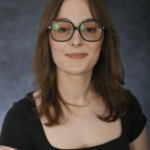
Exploring and Editing
Christina Schwab ’25, English and Theatre
Faculty Mentor: Dr. Bruce Graver
At 48 and 50 years of age, Dorothy and Mary Wordsworth accomplished the incredible achievement of crossing the Alps on foot to retrace William Wordsworth’s famed 1790 journey which formed the crux of The Prelude. Although William Wordsworth’s sister and wife were talented writers, their travel journals of this exhibition went largely unpublished. The most recent publication of their writing about this trip was an extremely abridged version of Dorothy Wordsworth’s journals, which was published almost a century ago. In my research, I will carefully analyze and transcribe pages from Dorothy and Mary Wordsworth’s travel journals. I will then compare them with the published version of Dorothy’s journals and write about my findings. By transcribing Dorothy and Mary Wordsworth’s travel journals and noting the important differences, I plan on uncovering important information about their lives and gaining valuable knowledge about these talented yet largely unrecognized women.
Undergraduate Research and Creative Projects Awards

The Effects of Corporate Incentive 936 on Puerto Rico’s Economic Development
Gabriel Capella ’25, Economics and Political Science
Faculty Mentor: Dr. Casey Stevens, Political Science
This research project explores the forces external/foreign to Puerto Rico’s economy that shaped the effects of Corporate Incentive 936 of the US Tax Code on the Island’s economic development from 1976 (when the Incentive was enacted ) to 2005 (when it was ended), and how these forces contributed to the Island entering a recession immediately after the Incentive’s phase-out. The research question is: What forces external/foreign to Puerto Rico’s economy shaped the effects of Corporate Incentive 936 of the US Tax Code on the Island’s economic development in the period 1976-2005, and how did these forces contribute to the Island entering a recession immediately after the Incentive was ended? To develop an answer to this twofold question, I rely on analytical readings of secondary literature by economists and political scientists, as well as National Archives investigations into Puerto Rican government official documents from the period.
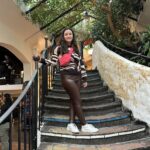
The New Right-Wing Populist: The Presentation of Female Candidates and Historical Roots
Christina Charie ’25, Economics and Political Science
Faculty Mentor: Dr. Casey Stevens, Political Science
With the rise of right-wing populism in European politics, female representation in political affairs is also increasing. France’s Marine Le Pen received 41.46% of the vote in the last presidential election. Giorgia Meloni of Italy became the first woman to hold the office of Prime Minister. What aesthetic decisions are being made by far-right female populist politicians? The research will seek to understand if the modern presentations have historical connections to earlier right-wing populist appearances and where they differ from the historical representations.
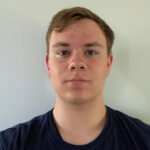
Gut Microbiome Research
Sean Coyne ’26, Biochemistry
Faculty Mentor: Dr. Tyler Stack, Chemistry and Biochemistry
The gut microbiome is a diverse and interesting frontier that many doctors and researchers are considering when looking at patient health. My research focuses on enzymes in the gut microbiome that modify corticosteroids, drugs that are similar to the stress hormone cortisol and are commonly used, like prednisone, fluticasone, and more. By characterizing different enzymes in the gut and how they react with the corticosteroids, I hope to one day help future medical professionals consider the gut microbiome when prescribing drugs, allowing them to consider any adverse reactions more effectively, and be able to consider the best treatment for an individual’s gut microbiome.
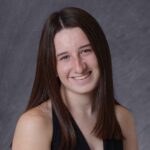
Uncovering the Mystery of Squid Sunglasses
Sarah Deeley ’25, Biology
Faculty Mentor: Dr. Hayden Boettcher, Biology
Squid eyes adapt to light in an extremely unique way. In humans, contraction and expansion of the pupil allows differing levels of light into the retina. Squid use a different mechanism that involves the movement of pigment granules, which act as molecular sunglasses. My research will aim to answer two specific questions: (1) What is the distribution of pigment granules within the squid photoreceptor and (2) what specific motor proteins are responsible for the movement of the pigment granules. One protein, the Amyloid Precursor Protein (APP), is linked to Alzheimer’s disease in humans. APP is present in squid, and understanding the role it plays within the visual system could help researchers better comprehend the progression of Alzheimer’s disease. Using a combination of light and electron microscopy, my research will advance our understanding of the squid visual system at a subcellular level and demonstrate the role of APP within that system.
Water on Europa and Triton
Erick Gonzalez ’25, Biology
Faculty Mentor: Dr. Noah Hammond, Engineering and Physics
This investigation seeks to find the cause of the formation of double ridges on Europa, one of Jupiter’s moons, and Triton, a moon of Neptune. Numerical models created by using MATLAB will be used to test different hypotheses for the formation of double ridges on these moons. Discovering the cause of these double ridges could prove that there is a subsurface ocean beneath the surface of the moons. This would be of great interest as it would mean that these moons could be hospitable in the future.
Competing Motivations in Adolescent Mice
Claire Kelly ’25, Neuroscience
Faculty Mentor: Dr. Ryan Post, Neuroscience
To survive in nature’s complex and ever-changing environment, humans and animals alike must be able to balance competing incentives. While adults are likely to express more proportionality in their behaviors, adolescence are known to demonstrate more impulsive actions. The goal of my research is to determine if adolescent mice reveal notable similarities to human behavior, emphasizing imbalanced motivations compared to adult mice. To achieve this, two behavioral assays are used in which fear and hunger are in conflict—the predator odor and open field tests. Time spent in the odor zone, as well as the amount of food consumed, is quantified to test for behavioral imbalance. The third test, tail suspension, complements the findings of the first two assays and measures motivation in terms of active struggling and passive inactivity. The results of these experiments lay the groundwork for comparing motivated behavior in juveniles and adolescents.

How Are Complex Words Recognized In Written Form
Aleksandra Kurylowicz ’27, Neuroscience
Faculty Mentor: Dr. Joanna Morris, Psychology
We are investigating a phenomenon where individuals deconstruct non-complex words into numerous parts, despite these words consisting of only one morpheme.
Research has revealed that skilled readers often deconstruct seemingly non-complex words like “corner” into separate components such as “corn” and “er,” despite this segmentation providing the actual meaning of “corner.” Furthermore, “corner” is a consistent word since when pronounced, both “corn” and “er” are uttered clearly and separately. However, words like “mother,” where the components “moth” and “er” are not utterly separately and rather blended together are inconsistent.
We hypothesize that through a masked priming technique, we would find that the participants shown the inconsistent words such as mother, would result in reduced priming especially when compared to the trials using consistent words such as corner. Conducting this could potentially unravel the mechanisms at play in identifying complex-words, thereby offering insights into the cognitive processes that underpin word recognition.
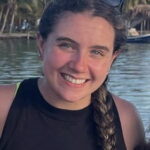
Reprioritization of survival needs during pregnancy in mice
Emma Morley ’25, Biology and Psychology
Faculty Mentor: Dr. Ryan Post, Neuroscience
The goal of this study is to understand how pregnancy reprioritizes competing motivations, of fear and hunger. We will accomplish this by analyzing the interaction of the competing responses to the threat and food in pregnant mice. I hypothesize that the dams (pregnant female mice), being hypersensitive to predator odors (Navarro-Moreno 2020), will not risk pursuit of the food adjacent to predator odor. I hypothesize that this hypersensitivity to threat will carry over to the open field and the visual threat stimulus. An open field presents an innate threat in the mice and the looming stimulus simulates a predator threat as well.

Sign and Reality: How the New Testament and the Church Fathers Define the Eucharist
Elisia Pagliuca ’25, Theology and Humanities
Faculty Mentor: Dr. James Dever, Theology
This research will be analyzing the biblical and Early Church definitions of the sacrament of the Eucharist in order to demonstrate that the Bible and the Early Church Fathers express both the sign value and the metaphysical reality of the Eucharist. She will be basing much of her research on Augustine’s Tractates on the Gospel of John, especially his treatment of Chapter 6 of the Gospel of John which contains the famous “Bread of Life Discourse.”

The Shift in Race and Ethnicity of Greek Mythological Figures
Angie Pierre ’25, Global Studies and History
Faculty Mentor: Dr. Elizabeth Palazzolo, History and Classics
As a part of my senior honors thesis in the History and Classics Department, this project aims at exploring the shift of race and ethnicity in Greek mythological figures. The project is exclusively examining this within Greece and the wider Mediterranean world during the Archaic, Classical, and Hellenistic periods. Moreover, this project will argue that the race and ethnicity of certain mythological figures changes as people from Greece become aware of other civilizations.

Genuine or Deception: A quantitative investigation into autocratic regimes gender reforms and gender initiatives
Catherine Raacke ’25, Political Science and Women & Gender Studies
Faculty Mentor: Dr. Adam Meyers, Political Science
What do greenwashing, pinkwashing, and gender washing all have in common? For starters, they all have the term “washing.” Secondly, they all involve the engagement of political deceit on the part of the corporation or state entity against the consumer or global citizens. Greenwashing and pinkwashing have been studied extensively in literature; however, gender washing has been confined to the field of State Feminism and has recently begun to emerge in International Relations. For this project, the topic of investigation will be gender washing within authoritarian regimes. The project will analyze the autocratic regime’s perceived commitment to gender initiatives versus their actual commitment. This will be done using indicators for gender equality. Such measures include the percentage of women in legislative bodies and school enrollment data for girls and boys. The end goal is to build a statistical case for gender washing based on a sample size of all autocracies.
Summer 2023 Veritas Undergraduate Research Awards
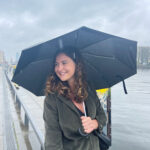
Hidden Voices: The Repression of Female Sexual Difference Under the Castroist Dictatorship and its Implications for Modern Cuban Society
Sarah Downey ’24, Spanish/Secondary Education
Faculty Mentor: Dr. Monica Simal, World Languages and Cultures
Within a patriarchal society, the woman is defined strictly in the realm of the man. Social institutions see the woman not as an autonomous being, but as a subordinate entity meant to satisfy male desires and conserve the traditional family structure. However, the repression of women is not uniform. Lesbian-identifying Cuban women experience a distinct intersection of gender, sexuality, and race that contributes to an array of challenges. During the Fidel Castro’s dictatorship (1959-2008), an epoch in which the political ideologies and laws in Cuba established a fervent opposition to homosexuality, to be ‘cubana’ and ‘lesbiana’ was irreconcilable. Over the course of my literary investigation, I will study the lesbian struggle for existence under the Castroist regime and the long-term effects of Castroist ideologies on modern-day Cuban society. The lesbian voice is one of the many voices that the dictatorship has silenced. I aim to bring visibility to this voice.

“The Whore Queen of Incestuous Canopus”: The Eroticization of Cleopatra VII’s Feminine and Ethnic Identity in Roman Literature and Art
Carley Medeiros ’24, History and Classics
Faculty Mentor: Dr. Robin Greene, History and Classics
The rulership of Cleopatra VII Thea Philopater is known in the modern conscious primarily through William Shakespeare’s “Antony and Cleopatra” along with popular Hollywood depictions of the glamorous, seductive Egyptian pharaoh. Ancient sources depicted Cleopatra similarly, criticizing her supposed seductress reputation, her foreignness, and, most especially, her womanhood. The foreign Egyptian queen threatened the power structure of Rome via her close relationships with Caesar and Mark Antony. Rome thus sought to condemn her public image and through art, poetry, and literature, vilified the young queen. Statues began to depict her as a vile seductress, literature described her as polluting and diseased, poetry denoted her deviancy and foreignness. Through an eroticization of Cleopatra Philopater VII’s political image, Roman elites effectively condemned Cleopatra’s ethnic identity and womanhood, expressing the perversity of such a rule; a gynaikokratia. This project seeks to understand how Cleopatra envisioned herself, analyzing ancient sources from a new perspective.
Aerobic Scope and Muscle Physiology
Mireille Kingsley ’24, Biology/Secondary Education
Faculty Mentor: Dr. James Waters, Biology
In this project, I will recruit student athlete participants who are training over the summer to measure the effects of increasing muscle composition and performance on their resting energy expenditure, aerobic scope, and time to fatigue. Data will be conducted over the course of 4 weeks, while student athletes follow a strength training program. Using the Apollo system I will be able to measure both resting metabolic rate and active metabolic rate. This data will allow us to see the changes in aerobic scope due to strength training over the course of 4 weeks. This research connects physiology, exercise science, the health science, and help shatter myths and educate student athletes about how our bodies really work.
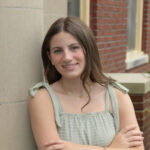
Stereotypes of Mathematics and Mathematicians in Media: A Review of Literature
Sarah O’Connor ’26, Mathematics
Faculty Mentor: Dr. Kevin O’Connor, Secondary Education and Dr. Olga Limnios, English
Published research on mathematics and mathematician stereotypes in media have been shared in the literature. However, a synthesis of this body of work does not exist. It is the purpose of this project to fill this gap and provide those interested in this area of research with a comprehensive review of its literature.

Examining the Theoretical Underpinnings of International Relations via a Case Study: the Globalization of Ideas within the 2022 Iranian Uprising
Catherine Raacke ’25, Political Science and Women’s and Gender Studies
Faculty Mentor: Dr. Sara Hassani, Political Science and Women’s and Gender Studies
Dominant international theory frameworks fail to account for the modern-day globalization of ideas. Frameworks such as Liberalism and Realism account for how countries interact internationally but do not account for how citizens within these countries interact with each other and subsequently influence their country’s political actors and institutions. This project will examine dominant theoretical frameworks—including Liberalism, Realism, & Marxism— in international relations alongside the more recent interventions made by constructivists and feminist scholars to analyze each framework’s strengths and weaknesses. It will examine their strengths and weaknesses by studying the current Iranian uprising, which began in September 2022, wherein globalization and the travel of ideas from Kurdish women’s struggles in Turkey and Syria have been central to shaping the predominant discourse of the “Woman, Life, Freedom” movement. The goal is to identify and assess which of these frameworks best accounts for globalization’s causal and constitutive effects and why.
Summer 2023 Undergraduate Research Awards

Gut Microbiome Research
Sean Coyne ’26, Biochemistry
Faculty Mentor: Dr. Tyler Stack, Chemistry and Biochemistry
The general goal of our lab is to research specific enzymes from bacteria in the gut microbiome to understand how they change the chemical structure of drugs. My proposed research specifically is looking at the enzymes that could modify corticosteroids. I will focus on two enzymes, specifically the “desmolase” which removes carbon atoms from cortisol and similar drugs, and then a dehydrogenase enzyme that can oxidize/reduce these molecules by characterizing the enzymes and the resulting molecules they produce.
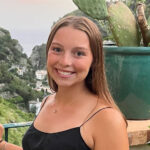
Impact of FTD on Behavior of Drosophila models
Megan DePoy ’24, Biology
Faculty Mentor: Dr. Marla Tipping, Biology
Frontotemporal Dementia (FTD) is the second most common form of early onset dementia. FTD is characterized by atrophy of the frontal and temporal areas on the brain. This project aims to asses the behavior in Drosophila melanogaster, fruit flies, that model the disease, as compared to those that do not. General activity levels of the two groups will form a baseline for behavior in FTD drosophila that can then be used in testing treatments for FTD. Smell-learning assays will also be conducted in order to understand the impact of FTD on the drosophila’s learning ability over time compared to the control group.

Mother Ocean: A Philosophy of Eros through Water
Ava Dobski ’25, Philosophy
Faculty Mentor: Dr. Jeffery Nicholas, Philosophy
Serious reflection on the relationship between science and spirituality has been around for at least 3,000 years. However, there still remains an important gap in traditional thinking about science and faith, especially in regards to the power of water. The goal of my research is to produce an academic essay that philosophically investigates the relationship between humans and water, primarily focusing on the concepts of water birth and Eros. Water birth has scientifically shown to increase the capacity for love in both mother and child. Eros is an unremitting sexual longing linked to the longing for immortality. The highest form of Eros is the Eros that opens one up to the promise of philosophy itself; to understand being. In its completion, my research will show that the reconnection between water and birth can create a fulfillment of Eros, one which can lead humans to reach their utmost potential for growth.

An Aristotelian Feminist Critique of The Real Housewives Franchise
Elizabeth Gates ’24, Philosophy
Faculty Mentor: Dr. Jeffery Nicholas, Philosophy
In this research, I seek to connect elements of Aristotle’s practical philosophy regarding human flourishing to popular modern media. I will focus specifically on The Real Housewives Franchise and the intersection of race, gender, and class portrayed on television. In this discussion, I will explore Aristotle’s pleonexia and vices pertaining to profit. This lens will inform a detailed feminist critique of Bravo’s portrayal of women as “real.” The Real Housewives Franchise has garnered a broad academic audience and I will consult these sources in my extended research. As a whole, the study aims to deconstruct the production of media and its place in culture. In doing so, it will be clear whether these programs are productive and empowering, or exploitative.

Consignment Store Market Research
Mary Gifford ’26, Social Science
Mentor: Kelly Ramirez, Ryan Incubator for Entrepreneurship in the Arts & Sciences
This research will expand upon the idea of a consignment store for Providence College students. The store will allow people to bring in their lightly worn clothes for an incentive as well as provide a place where students can buy items at affordable prices. Throughout the summer, I plan to conduct market and operational research to successfully launch a business that will serve both Providence College and the local community. The project will focus on understanding how a thrift shop model can work on a university campus, conducting web-based research on similar college-based models, conducting phone interviews with leadership teams running these ventures, and conducting community-based interviews to identify the needs of Providence locals. The expected impact of my research will be a greater understanding of the market and the ability to take the next steps confidently with experience and connections in the field.

Nos Populi: Classical Influences on Madisonian Thought & Modern Applications
Raymond Jarvis ’24, Political Science and Classics
Faculty Mentor: Dr. Patrick Breen, History and Classics
This project will be directed at analyzing the influence the ancient Greek and Romans had on James Madison’s contribution to the ratification of the United States Constitution, utilizing the Federalist Papers in conjunction with supplementary sources to understand Madison’s perspective, before turning toward attempting to adapt Madison’s solutions—for the mortal disease of faction—into a modern setting.

Principles in Practice: Father John LaFarge’s role in Shaping the Catholic Church’s Interracial Attitude in America and Beyond
John Perry ’24, Theology and History
Faculty Mentor: Dr. Patrick Breen, History and Classics
This thesis studies Father John LaFarge. LaFarge was the largest Catholic voice against racism in the early 1900s. A lot of his story has been documented, however, little attention has been given to what caused him to become such a big advocate for interracialism. LaFarge was able to connect principles and practice during a time when most Catholics did not. He challenged the Church and his nation to live up to the moral standard that they claimed to. This thesis examines the motivation needed for social action especially when it is against the grain. Lafarge believed that racism came primarily not from hate, but from apathy. In that spirit, this thesis is also a call against apathy at every level from a simple worker to a powerful institution.
Shear Heating and Double Ridges on Jupiter’s Moon Europa
Jeffrey Phan ’24, Engineering and Physics
Faculty Mentor: Dr. Noah Hammond, Engineering and Physics
This research investigates the double ridge formation on Europa which is an icy moon of Jupiter. A double ridg has two peaks and a trough and can be thousands of kilometers long and over a hundred meters tall. Through the use of mathematical numerical methods and a coding language named MATLAB, simulations will be created to determine how these ridges form. Shear heating is the theory that tectonic movement on Europa slips and slides much like it does on Earth, and this pushes the land upwards and can potentially form a double ridge. These double ridges are interesting because as the land is pushed upwards, the plate movement creates heat which may melt the surface ice and cause water to form. Water is the basis of life and if this shear heating model proves to be valid, it allows for more research on potential lifeforms on Europa.

American “Inferiority,” the Irish Connection, and the Radical Roots of the American Revolution
David Salzillo ’24, American Studies and History
Faculty Mentor: Dr. Edward Andrews, History and Classics
This research will trace the origins of the American Revolution to, above all else, Americans’ fears of being treated like the Irish in Ireland. By that, I mean that Americans (like Ben Franklin) worried that England’s notion of Americans as backward cultural inferiors would lead to English subjugation or “enslavement” of America. Then, I will argue that, given England’s exploitation of Ireland and its roots in anti-Irish prejudice, the Americans’ fears of a conspiracy to deprive them of their liberty were not necessarily so unreasonable. From there, I will tie Ireland’s development of a notion of “peoplehood” (i.e., separate from the English people) in the 18th century to America’s philosophy of self-determination in government (as seen in Common Sense, for example). I will conclude by exploring the radical implications of this view of the American Revolution.
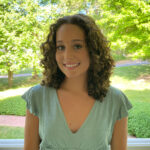
Art as a Form of Therapy: Afghan Women and their “War Rugs” Highlight the Trauma and Violence of the Soviet-Afghan War
Abigail Turano ’24, History
Faculty Mentor: Dr. Margaret Manchester, History and Classics
Woven rugs have been a traditional element of Afghan culture since nomadic women began carpet weaving thousands of years ago. From the outset of the Soviet-Afghan War, women started to incorporate symbols from this armed conflict—such as tanks, airplanes, and weapons—into their woven carpets, which became known as war rugs. Wartime themes of violence and death are represented in these rugs, as Afghan women used art to channel their resistance and share their traumatic experiences. This conflict had a devastating impact on Afghans, especially women and children. It is thus important to draw attention to the stories of women who fled the violence of the Soviet-Afghan War as well as those who created art to reflect on their wartime experiences. The gender-specific nature of the Afghan war rugs demonstrates the various ways in which women’s experience of war is unique.
Summer 2022 Veritas Undergraduate Research Awards

Transitive Inference in Rats
Shelby Bawden ’23, Biology, Psychology, Certificate of Neuroscience
Faculty Mentor: Dr. Victoria Temple, Psychology
Transitive inference (TI) can be used to create ordered representations of people and things. Rodents have shown to be capable of creating these mental lists through relational processes of TI, which require higher cognition to perform than associative learning processes (AL). In this study, it is hypothesized that if two groups of rats are presented with two five-item lists of odors, then the rats would be able to link both lists into one ten-item list as an ordered representation using relational processes. After showing if they use relational processes through the administration of probe trials. Probe trials would be administered after reaching criterion on both lists. Finally, to further understand the extent to which rats can use relational processes, list-linking pairs would be administered, such as BI, DG, and EF to assess if the rats created an ordered representation of the ten stimuli.
Providence’s highway system: urban development or dislocation?
Alec Fraggos ’23, History, Political Science minor
Faculty Mentor: Dr. Steven Carl Smith, History and Classics
This project investigates the urban development of Providence, Rhode Island and the impact the construction of I-195 and the 6/10 Connector highways had on the communities in the surrounding areas. Furthermore, the project analyzes the major points of influence that drove the city to construct these highways while simultaneously dislocating and isolating predominately communities of color. Similarly, this project also accounts for the resistance efforts in those communities that were forced to relocate as a result of the I-195 highway construction and the extent to which the city was receptive to the community’s concerns. Lastly, this looks at the connections between urban development and highway construction in twentieth century Providence and how the city viewed highways as mechanisms of this development.

Who Makes Them Blind?: A Novel in Ten Weeks
Fiona Clarke ’23, English and Art History
Faculty Mentor: Dr. Suzanne Fournier, English
This project is the draft of a novel tentatively entitled Who Makes Them Blind?, a title drawn from Exodus 4:11: “The Lord said to [Moses], ‘Who gives [human beings] their sight or makes them blind? Is it not I, the Lord?’” This line suggests two things: First, blindness and vision are common metaphors for perceptions of reality, and it is these characters’ “blind spots” that cause catastrophes for themselves and others. The line also hints that any person’s character is formed by another, that other ultimately being God. These characters are unable to fully explain themselves; instead, they must look outward to others (ultimately, God). This is a story of a woman who attempts to shut out all others, a woman who forgives too easily, a man digging his own grave in the midst of a murder trial, and a would-be psychoanalyst unable to read her own mind.

A Scepter of Terror or A Sword of Freedom: Elaine Brown’s time in the Black Panther Party
Maeve Plassche ’23, History/Secondary Education, Political Science minor
Faculty Mentor: Dr. Alyssa Lopez, History and Classics
Elaine Brown joined the Black Panther Party in 1968 and by 1974 she became the first and only woman to lead the Party. This project is going to analyze Elaine Brown’s time within the Black Panther Party and what her leadership meant for the Party and its female members. When Elaine Brown was leader she turned the Party’s attention to electoral politics and community service yet much of this work has gone unnoticed in the remembrance of the Black Panther Party. Elaine Brown’s time within the Black Party Panther helped to galvanize other Black women within the Party and as leader she allowed for these women to have a voice which was used to combat racial and gender oppression.
Summer 2022 Undergraduate Research Awards

Implicit Statistical Learning in Morphological Structure and Sub-lexical MO-LS Mappings
Natalia Alzate ’24, Biology and Psychology
Faculty Mentor: Dr. Johanna Morris, Psychology
The purpose of this study is to understand the different brain processes that occur in disorders like dyslexia. To determine potential differences between proficient and below will look at the ability to pick up on the internal structure of words. By distinguishing such differences, we aim to understand the process of word recognition and therefore design effective ways of aiding children in the process of learning to read. We plan to test the hypothesis that readers differ in their sensitivity to the internal structure of words and that these differences are both correlated with the participant’s ability to read. We plan to do this by measuring the (a) quality of readers’ lexical representations, (b) their sensitivity to the internal structure of words. We will correlate these behavioral measures with electrophysiological brain activity to identify neural signatures and determine if similar neural mechanisms are used in complex word recognition.
Providence Rhode Island: A Reflection of Inequality in the American Education System
Emily Cavanagh ’23, History
Faculty Mentor: Dr. Steven Carl Smith, History and Classics
This project combines scholarly research on education inequality and the urban history of Providence Rhode Island. The City of Providence and the Providence School System will be used as a case study to represent education inequality across the country. The goal of this project is to show education inequality from a nuanced point of view. In the past, research on education has fallen into two categories: Civil Rights and modern issues such as standardized testing. This project will combine both of these categories of research by drawing a connection between the Civil Rights issues such as segregated schools to modern issues of the achievement gap and standardized testing. This project will use local archives in Providence along with one archive in Boston.
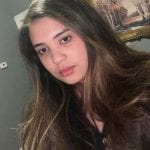
Art of Community
Nayely Furcal Marte ’23, Business Economics and Global Studies
Faculty Mentors: Dr. Nicholas Longo, Global Studies, Dr. Tuba Agartan, Health Policy and Management, and Professor Eric Sung, Art and Art History
I took an interdisciplinary Community Lens course: Art and Global Studies, which focused on telling stories through the camera lens. Reflecting on things involving our community was transformational for how I saw the city of Providence, where I grew up. It allowed me to use my eyes and art in new ways to find a larger vision. During the semester, I became part of an ongoing action research project with my faculty members, Professors Eric Sung, Dr. Nicholas Longo and Dr. Tuba Agartan, in the Arts of Community project. Which recently received an NEA grant to study the impact of Covid-19 and how the arts can be a vehicle for renewal. This research project will enable me to contribute to the Arts of Community through an original research project (the creation of a case study) and supporting an arts exhibition that will take place at WaterFire in September, 2022.
Brazilian Immigrant Youth, Belonging, and the Role of Education on Martha’s Vineyard
Kayla Luyo ’22, Sociology and Women and Gender Studies, Black Studies minor
Faculty Mentor: Dr. Kara Cebulko, Sociology
This research will be a continuation of my independent study, which is an extension of professor Kara Cebulko’s research on globalization and immigration on Martha’s Vineyard. I am currently researching the role of education systems and its impacts on Brazilian immigrant youths’ sense of belonging on Martha’s Vineyard. This semester I have interviewed two high school teachers from Martha’s Vineyard Regional High School from the English Language Learners department. This summer, I will conduct ethnographic research on the Vineyard, visiting these educational spaces and the communities on the island where Brazilians live. I will also use these pre-established contacts with teachers as entry points for conversations/ formal interviews with other educational staff. Additionally, I will meet with Brazilian immigrant-identifying graduates of MVRHS to better understand how their experiences at these institutions affect their experience post-graduation. These conversations will take place at their homes, workplaces, and favorite spots on the island.
Mapping the Thermal Environment and Modeling Its Impacts on Metabolic Physiology
Lily Palumbo ’23, Biology and Psychology
Faculty Mentor: Dr. James Waters, Biology
We want focus our research on seeing if having a more accurate, localized temperature and humidity sensor allows us to arrive at more useful predictions for insect metabolic rates than using the temperature and humidity available from existing networks of weather stations, supplying the information commonly reported through sources like the news and weather apps on our cellular devices. We want to create custom circuit boards with students from East Providence High School, while also teaching them about environmental aspects, as an outreach program. With these circuit boards, we want to be able to gauge location-specific temperature and humidity in a certain area, rather than relying on the reported values we are given. Simultaneously, we will be developing and deploying these sensors on campus at Providence College to help better understand the ecology of a new invasive species of ants on campus, the needle ant Brachyponera chinesis.

The Dignity of Desire: Recovering the Place of Eros in Christian Theology
Ana Botelho ’23, Theology and Philosophy
Faculty Mentor: Dr. Michael Wahl, Theology
The goal of this research is to expand upon the work started by Pope Benedict XVI by crafting a more extensive response to the Nietzschean charge that Christianity poisoned eros. This project will examine different definitions of eros throughout history in order to recover and distill an authentic conception of eros that, on the one hand, avoids subordinating it to agape, and on the other hand avoids separating it from or reducing it to sexual desire. This new conception of eros can then be used to refute the claim that Christianity poisoned eros.

Female Power and Influence across the Mediterranean during the Early Roman Empire
Jacqueline Elia ’23, History and Classics
Faculty Mentor: Dr. Melissa Huber, History and Classics
This project will examine instances of significant female influence and power within the public sphere of various cities across the Mediterranean during the early Roman Empire. My study intends to identify the truth behind a layer of Imperial Roman society and fill in the intentional historical gap created by Roman men who feared female independence in the public domain. This project will rediscover the narratives of societally influential women in the vast Roman Empire left out of the written historical record by analyzing their architectural contributions to their local societies and the subsequent power they earned for themselves through their benefaction.
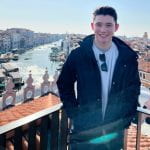
Flag Priming Effects on Shooter Bias
Patrick Kelly ’23, Psychology and Business Management
Faculty Mentor: Dr. Saaid Mendoza, Psychology
The purpose of this project is to build our knowledge on how racial bias can operate through priming of national symbols. Specifically, I hope to examine how identity salient flags (i.e., American flag and Blue Lives Matter flag) can work to influence prejudiced behavior towards Black individuals. This prospective research will use subliminal imagery to examine a potential increase in discriminatory behaviors, as measured by performance of a lexical decision task and a shooter bias task. Given that Blue Lives Matter was initiated in direct response to the Black Lives Matter movement, I hypothesize that priming individuals with this symbol will result in more subsequent bias being shown against Black individuals on a Shooter Bias task. The American flag will be used as comparison to examine how nationalism also may affect race-based decisions. This project could help demonstrate how symbols may contribute towards expressions of racially charged behaviors.
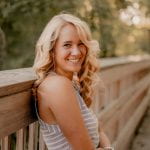
The Predation Resistance of Squashed E. coli
Kathryn Mulvey ’23, Biology
Faculty Mentor: Dr. Laura Williams, Biology
The goal of this project is to identify the mechanisms underlying changes in bacterial susceptibility to killing by the predatory bacterium Bdellovibrio. The Williams lab has observed that E. coli adopts a unique “squashed” colony morphology in the presence of the predatory bacteria strain NC01, and preliminary data indicates that the squashed E. coli is resistant to predation. I plan to explore this phenomenon through “wet lab” experimental approaches, such as predation efficiency assays, and computational biology approaches, including a thorough analysis of this bacteria’s genome and gene expression to identify the genes and conditions that prompt this defensive response. This research will not only contribute to new data concerning prey resistance to the literature, but also, will provide valuable information regarding bacterial resistance to predation, which is vital for developing new strategies to combat drug-resistant bacterial infections.
2021-22 Undergraduate Research Awards

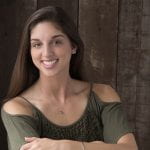
A patient-derived iPSC model to study glutamate deficiency by SHANK-3 Mutation in Autism Spectrum Disorder
Tiffany Berry ’22, Biology and Psychology
Courtney Caccia, ’22, Biology and Psychology
Faculty Mentor: Dr. Charles Toth, Biology
The use of human stem cell lines derived from persons with Autism Spectrum Disorder (ASD) provides a unique opportunity to model brain growth and potential to regain brain activity for treatment. Our lab has previously used stem cells to derive 3D cardiomyocytes to examine cardiovascular disease as well as kidney organoids and macrophages to study kidney disease. Using techniques our lab has learned using these stem cell models have prepared us to examine cell communication in mutated neurons. We will be examining glutamate levels of neurons in those affected by the SHANK-3 mutation. A lowered level of glutamate in cells is present in people with ASD due to a SHANK-3 deletion. We propose using stem cell lines derived from patients diagnosed with ASD who have the SHANK-3 deletion to derive neurons and astrocytes examine the effects of glutamate deficiency on cell communication.
The Identity Project
Jalynn Booker ’22, Environmental Biology
Faculty Mentor: Dr. Rachel Bonoan, Biology
I am conducting a series of interviews with both PC students and others to learn about the intersectionality and social identity theory in real time. I am looking to investigate what identity is to them, how they identify themselves, how they see identity in society, how society identifies them, and the impacts of this. There will be a documentary portion of this project, which will be showcased along with photos, featuring the interviews used for research. I am then going to interpret my findings and create a visual experience of people’s responses through a performative series of portraits with components of surrealism created in photoshop. This will be on exhibit in the Center @ Moore Hall in March, 2022.

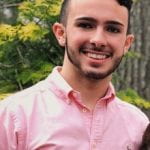

The localization of TMBI-4 in C. elegans
Kevin Ly ’22, Biology and Psychology
Zachary Mederios ’22, Biology and Health Policy and Management
Edy Pineda ’22, Biology
Faculty Mentor: Dr. Melissa Silvestrini, Biology
The goal of our research is to understand the cellular and genetic pathways that underlie aging. We use C. elegans as an ideal model to study the genetics of aging due to its short life cycle, transparent body, and easy maintenance in the lab. Various disorders that are linked to tmbi-4 mutations include the metabolic syndrome of aging, autophagy, and neurodegenerative disorders. Currently, there is no published data on the localization of TMBI-4 in C. elegans tissue. Using fluorescence microscopy, we will determine where TMBI-4 is found in the cell. This will provide more insight into the function of TBMI-4 in C. elegans. Our research may be useful to develop gene-targeting therapies that can be translated towards mammalian organisms, ideally to improve the quality of life of the aging population.


Differentiation and Maturation of Cerebral Organoids from APOE3/APOE4 Stem Cell Lines
Christopher Walsh ’23, Biology and Psychology
Hayden Lens ’23, Biology
Morgan Kruzan ’23, Biology
Isabella Glennon ’25, Biochemistry (pictured right)
Courtney Caccia, ’22, Biology and Psychology (pictured left)
Faculty Mentor: Dr. Charles Toth, Biology
This research aims to develop 3-D human stem cell models that can be used to study Alzheimer’s Disease. The project focuses on growing cerebral organoids, which share similar properties to normal brain development and function. We will be expanding upon the research from several labs from the past five years to help understand the mechanism of this complex disease. 3-D models are an important way to study neurological disorders because they can be used to examine possible drugs to treat the causes of many neurological diseases. These organoids will be generated using induced pluripotent stem cell lines (iPSCs) which will examine a gene considered a high-risk factor for the development of sporadic AD.


Transcription Factor HLH-11 as a Regulator of the Lipase ATGL-1
Megan Kutey ’22, Biology
Grace Kelley ’22, Biology
Faculty Mentor: Dr. Melissa Silvestrini, Biology
We have previously determined autophagy gene activity is required for normal lipid storage in C. elegans, but the understanding as to why remains uncertain. Our most recent observations have ruled out the cAMP-dependent PKA pathway as being responsible for this increased activity, and our attention has now turned to transcription factor HLH-11. As a known regulator of ATGL-1, overexpression of HLH-11 may be responsible for the mediation of ATGL-1 stability when autophagy is inhibited. We will measure the transcriptional activity in both wild-type animals and atg-7(bp411) loss-of-function mutants. Moreover, we will perform epistasis analysis to determine any potential genetic interactions between atg-7 and hlh-11. These experiments will provide further insight as to why the typically catabolic process of autophagy is required for the storage of lipids.

Discussion of Hope in Children
Kelly Drogan ’22, Psychology
Faculty Mentor: Dr. Jennifer Van Reet, Psychology
This project evaluates the relationships between hope and emotional regulation and hope and social support in children. The targeted age demographic will be eight to twelve year olds. The children will complete a series of surveys during the procedure. The first survey will evaluate their perception of hope for their future. The second survey will analyze how that child usually copes with stressful situations. The last survey will determine how much perceived social support the child is receiving in their life.
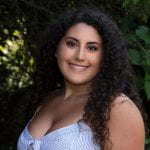
The Analysis of Mycobacteriophage “Rita”
Anna Fakhri ’24, Biochemistry
Dr. Kathleen A. Cornely, Chemistry and Biochemistry
Discovering new bacteriophages in order to further understand their genomic diversity serves as the primary objective of the SEA PHAGES project. The mycobacteriophage “Rita” was discovered during a five-week research period in a soil enrichment culture that was plated and plaque-picked. This semester the basis of the research project refers to the further analysis of Rita through the annotation of its genome sequence. Annotation will be completed using bioinformatics software such as DNA Master, Phamerator, and PECAAN. In annotating a bacteriophage genome, its genetic diversity can be determined through comparison to other phages of the same cluster. Phage genetic diversity is extensive and understanding its characteristics can aid in determining each individual phage’s ability to be utilized in phage therapy. Ultimately the continuation of researching Rita will provide insight on the phage’s unique genomic characteristics.
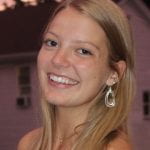
Effect of Pretense on Children’s Risk-Taking Behavior
Sophie Riddick ’22, Psychology
Faculty Mentor: Dr. Jennifer Van Reet, Psychology
I will be designing and running a study which will allow me to investigate whether pretending differentially affects children’s risk-taking behavior based on the character traits of the pretend identity. To do this, I have adapted a task from previous research to assess risk-taking behavior. I will have children complete this task either as themselves, while pretending to be someone safe, or while pretending to be someone not safe.
Summer 2021 Veritas Undergraduate Research Awards

Circadian Phase Shifts Effect of Social Jetlag on cellular metabolism and circadian genes in Wildtype Flies
Olivia Kozub ’23, Biology
Faculty Mentor: Dr. Pamela Snodgrass-Belt, Biology
Drosophila, like humans, have circadian clocks which regulate behavioral and physiological systems within the body. This “biological clock” is synchronized to the environment via temperature and/or light cycles. Small fluctuations in day-length trigger a reset of circadian clocks daily. However, large disruptions can cause health and stress issues such as social jetlag. Social jetlag occurs when an individual’s biological clock clashes with the timing of one’s sleep schedule determined by social factors and the demands of the day.
Navigating the Challenges Faced by Undocumented Immigrants Seeking Women’s Healthcare Services in the Providence Area
Grace Purvis ’22, Biology and Global Studies
Faculty Mentor: Dr. Tuba Agartan, Health Policy and Management
This project focuses on immigrant women’s access to women’s healthcare needs and on a narrower basis: undocumented immigrant women. My main goal is to better understand how undocumented immigrant women navigate women’s healthcare services in the Providence area.
An Unread Colonial Diary
Brigid McEvoy ’23, History and Spanish major with Business and Innovation and Latin American Studies minor
Faculty Mentor: Dr. Adrian Weimer, History and Classics
I will decipher the shorthand of the second half of Michael Wigglesworth’s diary. Wigglesworth was the most popular poet of Early New England. Despite scholarship on many of his famous poems, there is still much to be uncovered given that no one has yet deciphered the second half of his diary.
Summer 2021 Undergraduate Research Awards
Human Capital, Economic Growth, and the Appearance of Conditional Convergence
Brayden Binder ’22, Business Economics
Faculty Mentor: Dr. Fang Dong, Economics
Past research into the idea of “human capital” have examined the metric from one perspective. Either the researchers use the quality measurement of human capital, or the quantity measurement of human capital. Now, with the advent of the new version of human capital, being the combined quality and quantity metric, studies have shown that human capital can still be used to explain technological progress. Due to this, future research must either use both metrics or the combined metric in their models to provide the most up to date results in human capital literature. As such, the goal of this research is to further examine the effects of human capital on economic growth, namely GDP growth. The regression equation used will employ both metrics of human capital separately, along with a “catch up term.” Thus, through regression analysis, the research will be examining the role education plays in creating GDP growth.
Unfair Negative Portrayals of Nuclear Energy in Popular Culture
Alexander Cannon ’22, Theatre
Faculty Mentor: Dr. Matthew Guardino, Political Science
For over half a century, popular culture has depicted nuclear energy as something to be afraid or at least prohibitively cautious of. This is thanks to the conflation between nuclear bombs and nuclear reactors, and hyperbolic depictions of various nuclear threats found in popular movies, television shows, and video games. Specifically, this paper looks at the portrayal of nuclear energy in media such as Godzilla, The Simpsons, Fallout, and Call of Duty, and makes the connection that the influence these media products hold significantly colors the public’s perception of nuclear energy. Drawing on scholarly research in the fields of media studies, popular culture studies and nuclear science, this paper suggests nuclear energy has been misrepresented in popular culture.
Characterization of Immunity Systems in A Cluster Phages
Katherine Cleary ’23, Biochemistry
Faculty Mentor: Dr. Kathleen A. Cornely, Chemistry and Biochemistry
Bacteriophages are viruses that infect bacteria. Bacteriophages may use two different cycles to infect their hosts, which are the lytic cycle and the lysogenic cycle. During the lysogenic cycle, the phage genome integrates into the bacteria chromosome and becomes a part of the host. If a phage remains in the lysogenic cycle, the host is susceptible to infection from other bacteriophages. This process is known as superinfection and it can have a variety of outcomes. Homoimmunity occurs when the phages have similar repressor proteins. Heteroimmunity occurs when the phages have very different repressor proteins, so a complete infection can take place. When the phages have similar but distinct repressors, a partial infection of the lysogen can occur, which is called mesoimmunity. The goal of this project is to try to infect A5 cluster phage, Zolita, with other A cluster phages. This would allow us to determine if Zolita is mesolytic.
Solidarity and the Soviet Union
Jillian Forrester ’22, Global Studies and History
Faculty Mentor: Dr. Margaret Manchester, History and Classics
My project seeks to investigate the role that the independent trade union Solidarity played in the downfall of Soviet control over Poland. I plan to assess the union from the Soviet perspective and analyze how the Solidarity movement as well as internal Soviet political factors contributed to the de-Sovietization of Poland.
Comparison of 0057 and ML35 Genome Sequences to Determine Prey Range and Predation Efficiency
Jiana Ingrassia ’22, Biology
Faculty Mentor: Dr. Laura Williams, Biology
This project aims to use genome sequences to understand how genotypic variation affects phenotypic variation. This research will implement a combination of wet lab and computational techniques to assess what accounts for these differences in prey range and predation efficiency. Prey specific mechanisms, and how they affect predation, is widely unexplored, therefore assessing why variation in genotype occurs will help us better understand what features of prey bacteria make them more or less susceptible to predation. The specific goal of this project is to use computational methods to compare and contrast two different prey strains, and use this data to generate testable wet lab hypotheses. This data will help establish possible reasons for prey range variation and predation efficiency, contributing to the lab’s understanding of how predatory bacteria can be used in clinical therapies.
Determining the mechanism through which Sulforaphane reduces α-Synuclein levels in a Parkinson’s yeast model
Angela Mitsuma ’23, Biology and Music
Faculty Mentor: Dr. Melissa Silvestrini, Biology
Parkinson’s disease (PD) is the second most common human neurodegenerative disease. As such, it is important to investigate possible treatments. Numerous studies have shown α-Synuclein aggregation to be integral to the pathogenesis of PD. Thus, the Austriaco lab has conducted tests to determine Sulforaphane’s (SFN) impact on α-Synuclein levels in a Parkinson’s yeast model. Although our data demonstrates a reduction in α-Synuclein aggregation when using SFN, the mechanism behind this process is still unknown. The goal of my project is to determine if SFN reduces α-Synuclein levels through targeting the YAP1 pathway in yeast. SFN is known to target the KEAP1 pathway in mammals, which is very similar to the YAP1 pathway in yeast. Thus, the YAP1 pathway is a strong candidate for regulation by SFN.
Pilot Study: Further Investigating Neurophysiological Differences Among English Speakers
Joemari Pulido ’24, Psychology
Faculty Mentor: Dr. Joanna Morris, Psychology
The purpose of this pilot study is to examine how English speakers efficiently process complex words, in order to identify the brain patterns of brain responses that correlate with the processing of complex English words and how different this process is among individual English speakers. This pilot study will serve as a trial run of Dr. Morris’ ongoing research study “Neural correlates of visual statistical learning and morphological processing.” Furthermore, this research will help further characterize individual differences in the neurocognitive processes of native speakers of a language which is an important goal of recent research being done in this area of study.
Neural Correlates of Visual Statistical Learning and Morphological Processing
Tess Rooney ’22, Psychology, Neuroscience Certificate
Faculty Mentor: Dr. Joanna Morris, Psychology
My project aims to examine how complex words are processed in the brain. I will address the differences in reader sensitivity to varying structures of words and how this affects reader ability to recognize similar patterns in other sequences. Participants will be presented with complex words differing in structure. To examine how the brain reacts to these words, scalp-recorded event related potentials will be measured (ERPs). ERPs are small voltages generated in the brain in response to stimuli events that demonstrate the psychophysiological effects on brain processes. The findings from this study will provide insights into reader sensitivity and provide a foundation for further inquiry on learning disabilities, such as dyslexia.
Modern Anomalous Demographic (M.A.D): Diary of a Black Woman
Ekua Boakye-Mensah ’22, Political Science and Global Studies
Faculty Mentor: Dr. Zophia Edwards, Sociology
The goal of this project is to understand the complex effects that higher education has on first generation Black women, and the ways it alters and shapes their college experience overall. As a campus voice for women of color, this intersectional identity is essential to the success of many universities and workplaces. The idea here is that the experiences of first generation immigrants, combined with the marginalized identity of Black women, combine to create an intense and grossly under-supported college experience.
Destination, “The True Country:” The Significance of the Journey in Flannery O’Connor’s Fiction
Fiona Clarke ’23, English and Art History
Faculty Mentor: Dr. Suzanne Fournier, English
There are two types of journeys, physical or exterior journeys, such as the drive from Georgia to Florida, and spiritual or interior journeys, such as the progression from despair to hope, and a journey of either type has a destination. Flannery O’Connor often uses exterior journeys as outward manifestations of interior journeys, as in the case of the grandmother’s conversion on the road to Florida in “A Good Man is Hard to Find.” This research project will examine both types of journeys in O’Connor’s fiction, focusing primarily on her novel The Violent Bear It Away and her short story “The Displaced Person,” to establish the relationship between the interior and the exterior journeys and to determine whether there is a pattern to their beginnings and ends. This will be done in light of O’Connor’s Catholic belief in the “true country…what is eternal and absolute” as the end of all journeys.
Comparative Genomics of Bdellovibrio: Connecting Genotypes with Predation Phenotypes
Sidney Davis ’22, Biology
Faculty Mentor: Dr. Laura Williams, Biology
With the rise of antibiotic resistance, there is a need for alternatives to antibiotics. Predatory bacteria are able to attack plant and animal pathogens, making them potential biological alternatives to modern antibiotics. Based on the literature, there are several genera of predatory bacteria, each with differing predation methods. Though there have been publications focusing on genotypic and phenotypic variations among different genera of predatory bacteria and among different species of Bdellovibrio, there has yet to be a publication that compares the completed genomes of Bdellovibrio available. For my project, I will continue my work on my comparative genomics project on predatory bacteria in which I am investigating how differences in genotype relate to differences in predation. Employing a pangenomics analysis software, I will further explore how particular gene families differ between Bdellovibrio, such as the gene families for lytic enzymes, which predatory bacteria use to invade, digest, and lyse prey.
Surveying Southeastern New England for a rare butterfly, Frosted elfin (Callophrys irus)
Isabelle Heron ’23, Environmental Biology
Faculty Mentor: Dr. Racheal Bonoan, Biology
Conservation scientists have discovered an alarming trend that parallels the human-induced alarm of climate change. Similarly to the increase of global emissions and its effect on the environment, the degradation of global habitat has caused an “insect apocalypse”. While it may not seem as prevalent as the great effects that the climate crisis projects on others, the decline in insects means a loss in biodiversity. It also means losing pollination. Pollination is vital in reproduction and distribution of plants and it also provides resources for other animals. When people think pollination, think of bees, most people think of bees, however butterflies are also pollinators. With a decrease in insect populations, it has become more difficult to study their natural history and protect them. By studying insects, we gain a holistic understanding of ecosystems and have a better chance of successful conservation. My research will focus on the Frosted Elfin Butterfly.
Exploring the Relationship Between Healthcare Access and Cancer Diagnosis
Kara McCurdy ’22, Health Policy and Management
Faculty Mentor: Dr. Candidus Nwakasi, Health Policy and Management
Given the growing burden of cancer and the persistent issue of poor healthcare access in the country, this study explores the relationship between cancer and poor access to health. The study will use the 2019 National Health Interview Survey data (NHIS data) to examine the association between ability to pay for healthcare services and cancer diagnosis, and between healthcare utilization and cancer diagnosis.
How social behavior and interactions scale with group size in fruit flies
Leigh Paradis ’23, Biology
Faculty Mentor: Dr. James Waters, Biology
The interactions between individuals in social groups are important for how groups perform, but relatively little is known about how interaction patterns scale across different sized groups. Random models suggest that interaction frequency should depend only on density, but biological theory suggests that different kinds of social groups should exhibit different patterns. Using computer vision methods and the open-source R programming language, I will characterize the scaling of interaction rates in groups of fruit flies to test whether their behavior best matches either of the competing hypotheses. My research can be conducted remotely and the results will complement other ongoing projects in the lab involving measuring the metabolic rates of groups of flies.
Bermuda’s Maritime Economic, Geographical, and Political Importance and Expansion Leading Up to the Imperial Crisis from 1740 to 1800
Gretchen Richardson ’22, History
Faculty Mentor: Dr. Steven Smith, History and Classics
This research project will examine Bermuda’s economic, geographical, and political importance and expansion leading up to the Imperial Crisis from 1740 to 1800. The purpose is to understand how and why the island balanced two contradicting loyalties – as an aid to the rebelling colonies in their fight for independence while also remaining under the control of the Crown. This project will provide an answer to my overarching research question: How did Bermuda fit into the complex puzzle of the Colonies’ independence from the British Crown, and how did they, in turn, contribute to Bermuda’s success as a remaining British territory?
2020-21 Undergraduate Research Awards
Corporate Social Responsibility vs. Corporate Performance Analysis
Ethan Descoteaux ’21, Finance and Economics
Faculty Mentor: Dr. Fang Dong, Economics
A Biochemical Characterization of Mycobacteriophage Lysin A
Ethan Dionne ’22, Biochemistry
Faculty Mentor: Dr. Katheen A. Cornely, Chemistry and Biochemistry
Peltier Cooling and Heating Enclosure
Michael Lombardi ’23, Applied Physics
Dr. Erich Gust, Physics
ER Stress in C. elegans
Kevin Ly ’22, Biology and Psychology
Grace Kelley ’22, Biology
Zachary Mederios ’22, Biology and Health Policy and Management
Faculty Mentor: Dr. Melissa Silvestrini, Biology
Studio Art Thesis
Kali Magnusson ’21, Studio Art
Faculty Mentor: Professor Lynn Curtis, Art and Art History
Organic Struggle: Ceramics Thesis Exhibition
Shannon Rooney ’21, Mathematics and Studio Art
Faculty Mentor: Professor Judd Schiffman, Art and Art History
Metformin and Sulforaphane Reduce Alpha-synuclein Aggregation in a Yeast Model of Parkinson’s Disease
Yuri Takenaka ’21, Biology and Mathematics
Noah Kozub ’22, Biology
Faculty Mentor: Dr. Melissa Silvestrini, Biology
Stuck in Hot Water: Environmental Conditions Affecting Mysid Populations
Kristian Tomasic ’21, Biology
Jordan Pagliuca ’21, Biology
Lauren Flynn ’21, Biology and Mathematics
Faculty Mentor: Dr. Elisabeth Arévalo, Biology
Effect of Pretense on Children’s Risk Preferences
Sophie Riddick ’22, Psychology
Faculty Mentor: Dr. Jennifer Van Reet, Psychology
Providence College COVID-19 Oral History Project
Sarah Heavren ’21, History, Mathematics, and American Studies
Faculty Mentor: Dr. Steven Smith, History
The Effect of Circadian Phase Shifts on cellular respiration in wild type and flies with mutant circadian genes
Shannon Maguire ’22, Biology
Michael Yarrows ’22, Biology and Health Policy and Management
Kathryn Donohue ’22, Biology and Spanish
Faculty Mentor: Dr. Pamela Snodgrass ’91, Biology
Lo Afrocubano: Exploring Afro-Cuban Culture in Music, Literature, & Art, Pre- & Post-Revolution
Grace Maffucci ’22
Major: Music and Spanish
Faculty Mentor: Dr. Monica Simal, Foreign Language
Bessel Beam Optical Tweezers
Madison Altieri ’21
Major: Applied Physics
Faculty Mentor: Dr. Amer Hodzic, Engineering and Physics
Comparing Physician Assistant Program Mission Statements: Content Analysis
Cassidy DiRamio ’21 and Kate Cadigan ’21
Major: Health Policy and Management
Faculty Mentor: Dr. Robert Hackey, Health Policy and Management
Design and Development of an Inline Turbine: 3D Printed by CAD Software
Ashley Gigon ’22
Major: Engineering
Faculty Mentor: Dr. Theresa Moreau, Engineering and Physics
Beneath the Surface: Hadrian’s Underground Contributions to Roman Greece
Michaiah Kojoian ’21
Major: Classics
Faculty Mentor: Dr. Melissa Huber, History and Classics
Horizontal Gene Transfer in Fish
Matthew Rock ’23
Major: Biology
Faculty Mentor: Dr. Jeffrey Markert, Biology
Construction of K2 Mycobacteriophage Mutant
Olivia Schmitt ’22
Major: Biochemistry
Faculty Mentor: Dr. Kathleen A. Cornely, Chemistry and Biochemistry
Summer 2020 Veritas Undergraduate Research Awards

Intersectional Bias Reduction Through Imagined Contact
Alexandra L. Baker ’21
Major: Psychology, Women and Gender Studies
Minor: Spanish
Faculty Mentor: Dr. Saaid Mendoza, Psychology
The Ordeal of Joseph Wanton: Power, Protest, and the People in Revolutionary-Era Rhode Island
Sean M. Gray ’21
Major: History
Minor: Philosophy and Spanish
Faculty Mentor: Dr. Steven Smith, History and Classics
The Impact of U.S. Immigration Policies on LGBTQ+ Migrants From the Southern Border
Jolssen A. Rodriguez ’21
Major: Public & Community Service and Global Studies
Minor: Women & Gender Studies
Faculty Mentor: Dr. Christopher Chambers, Global Studies
Finding an Antimagic Labeling of the Cactus Graph
Victoria M. Sandner ’21
Major: Mathematics
Minor: Spanish
Faculty Mentor: Dr. Cayla McBee, Mathematics and Computer Science
Summer 2020 Undergraduate Research Awards
Synthesis of 2,6-Disubstituted Aryl Acetylenes For Use In The Synthesis Of Atropisomeric Molecules
Lorenzo D. Battistoni ’22
Major: Biochemistry B.S.
Faculty Mentor: Dr. Seann Mulcahy, Chemistry and Biochemistry
The Energy We Use
Madeleine Bristow ’21
Major: Biology (B.S.) and Psychology (B.A.)
Minor: Neuroscience
Faculty Mentor: Dr. James Waters, Biology
The Impact of Long-term Social Housing on Biconditional Association Task Performance and Neuron Ensembles in the Anterior Cingulate Cortex and Hippocampal CA3 Subregion
Anne M. Dankert ’21
Major: Biology and Psychology
Minor: Spanish and Neuroscience
Faculty Mentor: Dr. Victoria Templer, Psychology
Seventy Years Later: Caste Struggle in the Indian Bureaucracy
Kathryn V. Doner ’22
Major: Sociology, Global Studies, and Spanish
Faculty Mentor: Dr. Trina Vithayathil, Global Studies
The Effects of the Trump Administration on Immigrant Serving Organizations in the Greater Providence area
Odalis Y. Giron Flores ’23
Major: Sociology and Global Studies
Faculty Mentor: Dr. Kara Cebulko, Sociology
Building Social Solidarity After Social Distancing: What Can Be Done?
Alexandra M. Guzman ’22
Major: Elementary and Special Education
Faculty Mentor: Dr. Nicholas Longo, Public and Community Service
Shelton Shorthand in Seventeenth-Century Writings
Sarah R. Heavren ’21
Major: History, Mathematics, and American Studies
Faculty Mentor: Dr. Adrian Weimer, History and Classics
Growth Mindsets: Developing and Testing an Intervention to Increase Social Intelligence Among College-Age Adults
Anna N. LaFortune ’22
Major: Management and Global Studies
Faculty Mentor: Dr. Deirdre Snyder, Management
The Impact of FTD on Neuron Energy and Morphology
Sidney A. MacKinnon ’21
Major: Biology
Faculty Mentor: Dr. Marla Tipping, Biology
Keeping Native Language Alive: Understanding the Senegalese-American Pluralist Identity
Elisabeth J. Sudbey ’21
Major: Global Studies
Minor: French and Business and Innovation
Faculty Mentor: Dr. Nuria Alonso Garcia, Global Studies
Parental Response to Children’s Negative Emotions as a Mediator between Parental Coping Strategies and Children’s Symptoms of Psychopathology
Brooke D. Vitulli ’22
Major: Psychology
Faculty Mentor: Dr. Kelly A. Warmuth, Psychology
2019-20 Undergraduate Research Awards
The following are this year’s recipients of Undergraduate Research Awards.
Piezoelectricity and Hydropower Research
Ashley Gigon ’22
Faculty Mentor: Dr. Theresa Moreau, Engineering-Physics-Systems
Creating a Community
Patrick Fuller ’21 and Nicholas Crenshaw ’20
Faculty Mentor: Dr. Mary O’Keeffe, Psychology
Distribution of the cold water coral Astrangia in the waters of Narragansett Bay
Jared Getgano ’20, Sarah Ramsaran ’20, Victoria Hartley ’20, and Noah Mina ’20
Faculty Mentor: Dr. Joseph DeGiorgis, Biology
Examining the Relationship between Child Temperament, Parental Acceptance/Rejection, and Divergent Thinking in toddlers and preschool-age children
Elise Rogers ’20
Faculty Mentor: Dr. Kelly A. Warmuth, Psychology
The Role of Autophagy in Lipid Storage in C.elegans
Cristina de Corral ’22 and Samantha Otalvaro ’22
Faculty Mentor: Dr. Melissa Silvestrini, Biology
Venona Project Research
Mara Bergin ’20
Faculty Mentor: Dr. Margaret Manchester, History
The role of BAX Inhibitor-1 in ER stress in C. Elegans
Ibrahim Abaherah ’20, Michael Bittner ’21, and Kevin Ly ’23
Faculty Mentor: Dr. Melissa Silvestrini, Biology
A Miltonic Exhibition in a Blakean Museum: Milton’s Influence on William Blake’s Marriage of Heaven and Hell
Micaela Freeman ’20
Faculty Mentor: Dr. Bruce Graver, English
Investigation of the role of mitochondria in metastatic potential of ovarian cancer cells
Eliana DaCunha ’22, Christopher Lautato ’21, and Matthew Lautato ’21
Faculty Mentor: Dr. Yinsheng Wan, Biology
Haemophilus influenzae carbonic anhydrase (HICA) kinetic assay
Ella Sheehan ’20
Faculty Mentor: Dr. Katheen A. Cornely, Chemistry and Biochemistry
Perceptions of Disability
Alexandria Powers ’20
Faculty Mentor: Dr. Mary O’Keeffe, Psychology
A study of Zoej
Colby Agostino ’22
Faculty Mentor: Dr. Katheen A. Cornely, Chemistry and Biochemistry
Drosophila Models of Neurodegenerative Diseases
Ella Clifford ’20 and Jackson Diltz ’22
Faculty Mentor: Dr. Marla Tipping, Biology
Studying Cardiovascular Disease Using Human Stem Cell-derived 3D Cardiomyocytes
Nicholas Dash ’20 and Veronica Bohl ’20
Faculty Mentor: Dr. Charles Toth, Biology
Exploration of Phage Incubation Temperatures
Ethan Dionne ’22
Faculty Mentor: Dr. Katheen A. Cornely, Chemistry and Biochemistry
39 and Me: The Evolution of Dogs through the Study of Genomics
Lauren Flynn ’21, Kathleen Kuhl ’22, Jordan Pagliuca ’21, and Megan Russel ’20
Faculty Mentor: Dr. Elisabeth Arévalo, Biology
Modeling the Long-Term Effects of Vincristine on Female Fecundancy in Drosophila melanogaster
Abigail Harrington ’21 and Grace Shapiro ’21
Faculty Mentor: Dr. Marla Tipping, Biology
Using Goals to Predict Psychological Outcomes Among Majority and Minority Students Follow Up Study
Andre Rogers ’20
Faculty Mentor: Dr. Eliane Boucher, Psychology
Exploration of Novel K2 Mycobacteriophage
Olivia Schmitt ’22
Faculty Mentor: Dr. Katheen A. Cornely, Chemistry and Biochemistry
Design, Construct, and Operate a Radio Telescope
Richard Thomson ’21
Faculty Mentor: Dr. Joseph Ribaudo, Engineering and Physics
Summer 2019 Undergraduate Research Awards
The following are this summer’s recipients of Undergraduate Research Awards.
Digital Humanity VR Project
Liam Bixby ’21
Major: Computer Science
Faculty Mentor: Professor Bing Huang, Art and Art History
Across the Aisle
Olivia Braga ’20
Major: Health Policy and Management
Faculty Mentor: Dr. Todd Olszewski, Health Policy and Management
Providence College Through Artificial Reality
Ryan Britt ’21
Major: Mathematics
Faculty Mentor: Professor Bing Huang, Art and Art History
Women in Ancient Roman Literature: the Use of Mulier
Emily Conley ’20
Major: Political Science and Classics
Faculty Mentor: Dr. Robin Greene, History and the Classics
Race, Class, and Politics in Newark N.J.
Fredson Desravines ’21
Major: Global Studies
Faculty Mentor: Dr. Natoschia Scruggs, Global Studies
Youth Homelessness and Rapid Re-Housing Programs in Rhode Island
Laura Fusco ’20
Major: Public and Community Service
Faculty Mentor: Dr. Keith Morton, Public and Community Service
The Dialogue, Inclusion, and Democracy (DID) Wall
Quess-Symphonee Johnson ’21
Major: Global Studies
Faculty Mentor: Dr. Nicholas Longo, Public and Community Service
Casteism in Indian Academia
Diana Mora Bermejo ’21
Major: Global Studies and Health Policy and Management
Faculty Mentor: Dr. Trina Vithayathil, Global Studies
Application of Black-Scholes Model in Option Pricing and Intangibles Assets
Giang Nguyen-Hoang ’20
Major: Finance and Mathematics
Faculty Mentor: Dr. Joseph Shomberg, Mathematics
The Effects of Changes in US Refugee Policies on Domestic and International Refugee Practices
Mallory Pletzer ’21
Major: Global Studies and Political Science
Faculty Mentor: Dr. Notaschia Scruggs, Global Studies
The Soviet Arc: The USS Buford and anti-Anarchist Sentiment in post-War America
Daniel Rooney ’21
Major: American Studies
Faculty Mentor: Dr. Jeffrey Johnson, History and American Studies
Modeling Parkinsons Disease in the Budding Yeast, Saccharomyces
Yuri Takenaka ’21
Major: Biology and Mathematics
Faculty Mentor: Fr. Nicanor Austriaco O.P., Biology
Residential Segregation by Caste in Indian Cities
Alicia Terrero ’21
Major: Global Studies and Political Science
Faculty Mentor: Dr. Trina Vithayathil, Global Studies
Nestorianism, the Luminous Religion, in China: Journey, Survival, Confusion, Compromise and Energy
Tianyi Yuan ’20
Major: Theology and Philosophy
Faculty Mentor: Dr. Arthur Urbano, Theology
2018-19 Undergraduate Research Awards
The following are this year’s recipients of Undergraduate Research Awards.
Modernizing Classic Figures from the 20th Century
Olivia D’Elia ’19
Major: Studio Art Photography
Faculty Mentor: Eric Sung, Photography
The Effect of Social Role Theory and Gender Incongruence on Mate Desirability
Monica Morenz ’19
Major: Management and Psychology
Faculty Mentor: Dr. Eliane Boucher, Psychology
The Afro-Latina Experience: Rhode Island Healthcare and Afro-Latina Women
Sara Jean-Francois ’19
Major: Psychology and Health Policy and Management
Faculty Mentor: Dr. Jessica Mulligan, Health Policy and Management
The Impact of Disability Models on Disability Attitudes: An Investigation of Therapeutic Approaches to Treatment
Josette Tugander ’19
Major: Psychology
Faculty Mentor: Dr. Mary O’Keeffe, Psychology
Guppies as a genetic model for population fitness in dynamic environments
Sam Lomax ’20
Major: Biology
Faculty Mentor: Dr. Jeffrey Markert, Biology
You’re A Goodman Charlie Brown
Theodore Kiritsy ’19
Major: Musical Theatre
Faculty Mentor: James Calitri, Theatre, Dance, and Film
Using Human Stem Cell Derived Kidney Organoids to Study Kidney Disease and Inflammation
Veronica Bohl ‘2
Major: Biology and Psychology
Victoria D’Agostino ’20
Major: Biology
Truman Dunkley ’20
Major: Biology
Faculty Mentor: Dr. Charles Toth, Biology
Dog Designing and Evolution: The Good, The Bad, and The Genomics
Gregory Papas ’20
Major: Psychology
Jordan Pagliuca ‘2
Major: Biology
Lauren Flynn ’21
Major: Biology and Mathematics
Faculty Mentor: Dr. Elisabeth Arevalo, Biology
Concerning Dinner
Isabella Christilles ’19
Major: Studio Art
Faculty Mentor: Stephen Lacy, Art and Art History
A study of K2 Mycobacteriophages
Amy Conte ’19
Major: Biochemistry
Colin Scano ’19
Major: Chemistry and Biochemistry
Grace Grimaldi ’19
Major: Biology
Fiona Anonuevo ’19
Major: Biology
Faculty Mentor: Dr. Katheen A. Cornely, Chemistry and Biochemistry
Utilizing Mapping of Narragansett Bay to determine both the change in Eelgrass (Zostera marina) cover and the amount of the algal species present
Karalyn Falck ’19
Major: Biology
Faculty Mentor: Dr. Patrick Ewanchuk, Biology
Health Care Workers in Puerto Rico: Adversity and Resilience after Maria
Ann Gross Almonte ’19
Major: Health Policy and Management
Lauren Guerra ’19
Major: Health Policy and Management
Faculty Mentor: Dr. Jessica Mulligan, Health Policy and Management
Modeling Parkinsons Disease in the Budding Yeast, Saccharomyces
Victoria Haak ’20
Major: Biology
Liam McDonough ’19
Major: Biology
Yuri Takenaka ’21
Major: Biology
Alissa Pacheco ’21
Major: Biology
Faculty Mentor: Fr. Nicanor Austriaco, O.P., Biology
The Effect of Specific Prototype Matching on Interest in Science: a replication and extension
Rebecca Hardenstine ’19
Major: Psychology
Faculty Mentor: Dr. Eliane Boucher, Psychology
Mechanical Light
Michael Jimenez ’19
Major: Physics
Faculty Mentor: Dr. Theresa Moreau, Engineering-Physics-Systems
Solar Energy Policy Research
Kathleen Kuzmin ’19
Major: Economics
Giana Paolicelli ’20
Major: Economics
Matthew Carlson ’20
Major: Finance
Faculty Mentor: Dr. Fang Dong, Economics
Atomic and Molecular Spectroscopy
Emma McLaughlin ’20
Major: Applied Physics
Amelia Paladino ’19
Major: Physics
Duncan McGinnis ’19
Major: Physics
Faculty Mentor: Dr. Seth Ashman, Engineering-Physics-Systems
Contemporary Significance of Craft and Pattern
Jessica Rogers ’19
Major: Studio Art
Faculty Mentor: Judd Schiffman, Art and Art History
Solar Energy Project
Elijah Stewart ’21
Major: Engineering
Olivia Dickinson ’21
Major: Applied Physics and Mathematics
Faculty Mentor: Dr. Seth Ashman, Engineering-Physics-Systems
When policy can mean life or death: The story of a woman living in Florida
Madeline Weil ’19
Major: Health Policy and Management
Julia Scheuring ’21
Major: Health Policy and Management
Faculty Mentor: Dr. Jessica Mulligan, Health Policy and Management
Avian Elbow Mechanics
Briana Barns ’20
Major: English (Pre-Med)
Faculty Mentor: Dr. David Baier, Biology
Infusing Technology in the Classroom
Madeleine Clark ’19
Major: Elementary and Special Education
Faculty Mentor: Dr. Marcy Zipke, Elementary Education/Special Education
A Locally Inspired Addendum to “Classic Beauty: 21st-Century Artists on Classical Form and Antiquity”
Melanie Frichhione ’19
Major: Public and Community Service
Faculty Mentor: Jamilee Lacy, Art and Art History
IDH Gene Expression and DNA Repair of Drosophila
Samantha Nicodemus ’20,
Major: Biology, Psychology, and Mathematics
Faculty Mentor: Dr. Marla Tipping, Biology
What Remains: The Story of the Black Cab Tours of Belfast
Maura Wester ’19
Major: History
Faculty Mentor: Dr. Darra Mulderry, History
Get Involved
At Providence College, students in all disciplines work in partnership with faculty mentors to conduct original research and scholarship, an opportunity often reserved for graduate students at larger institutions. We take our students seriously and they take their work seriously. And when they graduate, they have the skills and experience that make prospective employers and graduate programs take them very seriously.
Dr. Jennifer Van Reet
Director of the Center for Engaged Learning
Professor of Psychology
Library 211
401.865.1824
jvanreet@providence.edu
Amy Goggin
Assistant Director of the Center for Engaged Learning
Library 212
401.865.1834
agoggin@providence.edu






